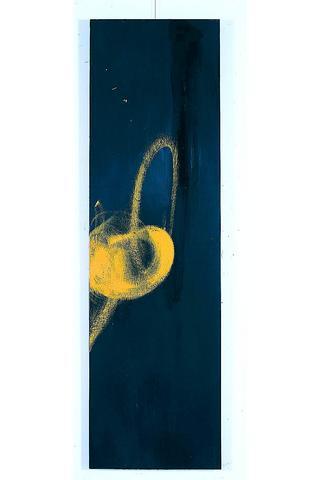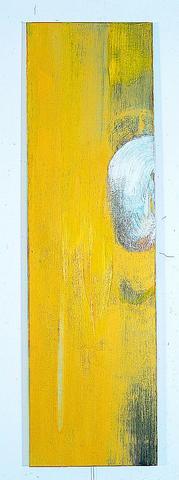When the artist who calls himself Abugy (
It was one of those moments when children shock adults with their immediate and spot-on insight, because the ring in a bull's nose is an image used in the practice of Zen meditation, of which Abugy is a devoted student. His paintings are a reflection of his ongoing inner search, and the fact that his son happened coincidentally upon a Zen image reinforced his belief that enlightenment entails achieving the totally free consciousness of a child. Along with meditation and studying, painting is one way in which he aims to get to that point.

Ring on the Bull's Nose features over 20 oil paintings, almost all of then completed this year and which earned Abugy -- whose name is a Mandarin phoneticization of a Japanese term for fat boy -- the Liao Chi-chun Oil Painting Award for outstanding young artists (Abugy is 39).

It's difficult to discern if the paintings are tools for meditation or the results of it. No matter which they are, the meditative aspect in each image comes though in the blur of colors that Abugy says tries to break down the time-space continuum. And there is unquestionably a force in many of the canvases that draws the viewer in so that several minutes could slip by in what seems like a mere second.
Viewing the paintings, according to Abugy, should be an experience similar to his own in making them -- they need a clear and peaceful mind. For him, working in this way has become a lifestyle, which he describes as pure and simple and basically the antithesis of the hip, urban artist, whom he views with thinly veiled scorn. Too many people involved in art, he said, are seeking some form of self-aggrandizement, or at the very least, desire the public's applause. One could say that he's more interested in the sound of one hand clapping and the impenetrable logic puzzles that his images raise.
Abugy is hardly the first to use oil on canvas for conceptual pieces that delve explicitly into Buddhist philosophies, but his use of color and form achieves a rare kind of grace that begs for a longer look, even though he says they don't require any more time than a split second.

In the March 9 edition of the Taipei Times a piece by Ninon Godefroy ran with the headine “The quiet, gentle rhythm of Taiwan.” It started with the line “Taiwan is a small, humble place. There is no Eiffel Tower, no pyramids — no singular attraction that draws the world’s attention.” I laughed out loud at that. This was out of no disrespect for the author or the piece, which made some interesting analogies and good points about how both Din Tai Fung’s and Taiwan Semiconductor Manufacturing Co’s (TSMC, 台積電) meticulous attention to detail and quality are not quite up to

April 21 to April 27 Hsieh Er’s (謝娥) political fortunes were rising fast after she got out of jail and joined the Chinese Nationalist Party (KMT) in December 1945. Not only did she hold key positions in various committees, she was elected the only woman on the Taipei City Council and headed to Nanjing in 1946 as the sole Taiwanese female representative to the National Constituent Assembly. With the support of first lady Soong May-ling (宋美齡), she started the Taipei Women’s Association and Taiwan Provincial Women’s Association, where she

It is one of the more remarkable facts of Taiwan history that it was never occupied or claimed by any of the numerous kingdoms of southern China — Han or otherwise — that lay just across the water from it. None of their brilliant ministers ever discovered that Taiwan was a “core interest” of the state whose annexation was “inevitable.” As Paul Kua notes in an excellent monograph laying out how the Portuguese gave Taiwan the name “Formosa,” the first Europeans to express an interest in occupying Taiwan were the Spanish. Tonio Andrade in his seminal work, How Taiwan Became Chinese,

Mongolian influencer Anudari Daarya looks effortlessly glamorous and carefree in her social media posts — but the classically trained pianist’s road to acceptance as a transgender artist has been anything but easy. She is one of a growing number of Mongolian LGBTQ youth challenging stereotypes and fighting for acceptance through media representation in the socially conservative country. LGBTQ Mongolians often hide their identities from their employers and colleagues for fear of discrimination, with a survey by the non-profit LGBT Centre Mongolia showing that only 20 percent of people felt comfortable coming out at work. Daarya, 25, said she has faced discrimination since she